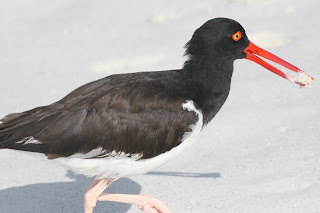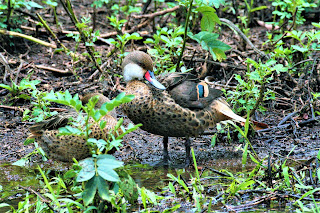The Beagle at anchor
The flight from Quito via Guayaquil was straightforward enough apart from a little moment when we first arrived in the Galapagos. All the luggage came off the plane with the exception of Alan's suitcase and he had visions of spending ten days on the islands without his camera. Fortunately, after a brief but heart-stopping few minutes they found his suitcase and all was well.
The airport itself is located on the uninhabited Isla Baltra so first of all we had a coach trip from the airport across this barren island. We then transferred our luggage onto a small ferry which took us across the narrow channel to the island of Santa Cruz and from there we were driven 45 kilometres to Puerto Ayora where 60% of the population of the Galapagos live, some 70,000 people. Then finally we boarded The Beagle!
There were five crew on board, plus a bi-lingual naturalist guide, and twelve paying guests. Being herded around in a group is not really our thing (especially not Alan's) but this is the only way you can visit the islands. We found ourselves sharing our experience with two other Brits, two Australians, two Germans, two Canadians, an American and a South Korean, all of whom turned out to be very pleasant people and good company.
Our cabin was very compact and took a little getting used to, at least the bunk beds did. Alan learned the hard way that sitting bolt upright in the middle of the night was not a good idea as it resulted in his head somewhat painfully meeting the underside of the top bunk.
Tuesday afternoon was spent at Puerto Ayora where we visited the Charles Darwin research station and saw numerous giant tortoiseses, everything from hatchling size to fully grown adults. They apparently repatriate the tortoises to their home islands when they are about four years old. We also had the pleasure of seeing Lonesome George, famous for being the last surviving member of the Isla Pinta subspecies of tortoise. Apparently, considerable effort was put into encouraging George to mate with females from a closely related subspecies but sadly George died in 2012 without having produced any offspring. By the time we got to see him the taxidermists had been at work and he was standing proudly, head held high, within a glass cabinet.
Portrait, giant tortoise
Giant tortoise addressing a serious question
Pelican in mid swallow
Galapagos mocking bird
The Beagle then took us on our very own voyage of discovery around the south and central Galapagos islands. Tourism is very strictly managed to protect the wildlife and the environment so our boat followed a rigid itinerary to specific sights at specific times and in consequence we hardly ever found ourselves visiting a sight at the same time as another boat.
Galapagos map (the blue line was our route)
Our schedule each day, with some minor variations, was breakfast at six am, followed by a walk of about two hours from seven am followed by snorkelling for one to two hours. After all that activity we then relaxed and lunched on the boat during the heat of the day until about three pm when there was more snorkelling, followed by another walk at about five. The boat generally cruised to the next island or site in the middle of the day, in the evening when we were relaxing or at night.
We discovered that every island is different, both in terms of its geology and the different species of wildlife that inhabit it. The youngest islands are about 100,000 years old and are still very barren consisting of craggy volcanic rock and ash and supporting little in the way of life other than a few small cacti and lizards. In contrast, the oldest islands are about ten million years old and have considerable vegetation, including forest. Only four islands, Santa Cruz, Floreana, San Cristobal and Isabela are inhabited.
Blow hole
Cactus in bloom
Kiker rock
Pirate cave
Our walks on the various islands were pretty hot and sweaty but they were more than worth it to see the blue footed boobies doing the 'Booby Cokey', the male frigate birds displaying their huge red balloons which is their symbol of sexual superiority, iguanas lazily lying under a cactus or scurrying across the lava and sea lion pups suckling from their mothers, all within touching distance.
Marine iguana
Portrait, marine iguana
Close up, marine iguana
Marine iguana showing breeding colours
Close up, marine iguana in breeding colours
Male marine iguanas showing breeding colours
Blue footed boobies courting
Blue footed booby with eggs

Altogether now for the Booby Cokey

You put your left foot in
You put your left foot out

In out, in out, and shake it all about
Sea lion portrait
Sea lion having a scratch
Sea lions at play
Sea lion chorus
Sea lions play fighting
I'm bored, anyone want to play?
Come on, I want to play
That's better!
More sea lion fun
Sue getting up close and personal

Where's my Mum?
Sometimes it all gets too much
Breakfast time for sea lion pup
Mother love, sea lion style
Nazca boobies courting
Portrait, Nazca booby
Nazca booby with chick
Pink flamingos feeding
Pink flamingo with reflection
Ballet class
Turtle tracks in the sand
Galapagos dove
Galapagos hawk
Swallow tailed gull
Close up, swallow tailed gull
Close up, swallow tailed gull
Swallow tailed gulls with chick
Sally Lightfoot crabs
Group of Sally Lightfoot crabs
American oystercatcher
American oystercatcher

Red billed tropic bird
Land iguana
Land iguana
Land iguana and cactus
Land iguana
Male frigate bird displaying
Female frigate bird
Close up, male frigate bird
Female frigate bird with chick
Male frigate bird in flight
Whilst we were cruising on the Beagle we were entertained by pods of a hundred or more dolphins swimming and jumping alongside the boat, several mighty big manta that breached and in a couple of cases did 360 degree somersaults, belly flopping back into the water with a resounding splash and, on our last morning, a couple of green turtles mating rather noisily (apparently rather reluctantly in the case of the female).
Dolphin sounding
Razor surgeon fish on the surface
Galapagos shark patrolling past the boat
Green turtle
The Beagle passing Bartoleme rock at evening
Galapagos penguin
We both agreed that this was the best snorkelling that we've ever had anywhere and we always came back onto the boat absolutely buzzing with what we had seen and experienced.
Galapagos fish chart
Galapagos fish chart
Our one regret was that we did not have an underwater camera to capture the wonderful world beneath the surface but needless to say it felt like we had seen the entire panoply of tropical marine life in amongst the rocks and coral. We swam through and close to numerous shoals of brightly coloured fish, completely unafraid unless they were being pursued by a sea lion when they then became rather more frantic, we had juvenile sea lions swimming with us and around us, sometimes spinning and corkscrewing around each other so their bodies were completely intertwined, and on one occasion a penguin dived off a rock in front of Alan and torpedoed itself right between his legs.
On one snorkelling session we jumped off the boat and landed immediately above a school of hammerhead sharks, we lost count at about thirty. We saw green turtles, manta rays, eagle rays, white tip sharks and a few larger Galapagos sharks, one of which got slightly too close for comfort.
All good things have to come to an end and before we knew it a week had passed and we were saying goodbye to the Beagle and to the friends that we had made on board. We returned to Puerto Ayora where we checked into a very nice hostel for our last few days in the Galapagos.
Puerto Ayora turned out to quite a bustling place and everything that the outlying islands of the Galapagos were not. It was busy, full of restaurants, gift shops and tour agencies but it didn't feel tacky and the sun shone, the food was good, the frigate birds were diving on the fish in the harbour so life was still good.
Alan went for a couple of dives on Wednesday which he reported were an amazing experience. His diving group had nine or ten large black tip sharks swimming around them and near them and he could see the whites of their eyes and the texture of their skin and he could have reached out and touched them. At another point he looked up and there was a 'flight' of half a dozen spotted eagle rays sailing gracefully over his head. And of course, the water was full of all the other beautiful tropical fish that we had seen on our numerous snorkelling trips.
Our last day in the Galapagos was spent having a look at some of the interior of Santa Cruz island including some spectacular sinkholes created when subterranean lava flow caused the ground to collapse. We had a walk inside some lava tunnels which were created when the exterior of the lava flow solidified on the outside but continued flowing on the inside. Then we had a final look at some giant tortoises which were entirely unimpressed by us.
Sink hole, Santa Cruz island
Coming out of the lava tunnel, Santa Cruz
Small person, large tortoise
Do I know you?
Mid morning snack
Galapagos pintail duck, Santa Cruz
There are not enough superlatives to describe how amazing our visit to the Galapagos Islands has been. We both agreed that it has been the highlight of our travels so far, just as well it was near the end of our trip rather than at the beginning because it would be hard to beat.
Today is Saturday 11th March and we are back in Quito. Tomorrow we continue our journey south.







































































